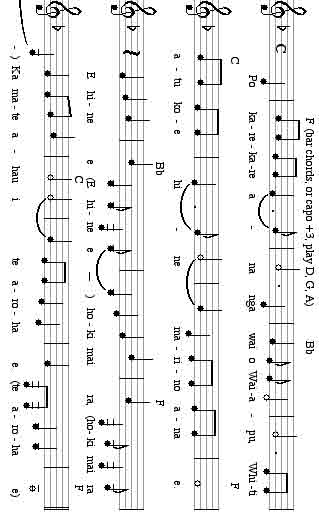| NEW ZEALAND |
POKAREKARE ANA for cellphones |
Home - Māori
songs - Kiwi songs
Soldiers from Northland composed this at the beginning of World War One.
| Pōkarekare
ana ngā wai o Waiapu, Whiti atu koe hine marino ana e. |
They
are agitated the waters of Waiapu, If you cross over girl they will be calm. |
| E hine e hoki mai ra. Ka mate ahau I te aroha e. |
Oh girl return to me, I could die of love for you. |
Tuhituhi taku reta tuku atu taku rīngi, Kia kite tō iwi raru raru ana e. |
I've written my letter I've sent my ring, so that your people can see I'm troubled. |
| Whatiwhati taku
pene ka pau aku pepa, Ko taku aroha mau tonu ana e. |
My pen is shattered, I have no more paper But my love is still steadfast. |
| E kore te aroha e maroke i te rā, Mākūkū tonu i aku roimata e. |
Never will my love be dried by the sun, It will be moistened by my tears. |
Play this
140KB mp3 sound clip
by Dame Kiri Te Kanawa.
3. Chord and strum guide
D Po-ka-re-ka-re
a-na dum-de-dum |
| E hi-ne e G E hi-ne e Ho-ki mai ra D Ho-ki mai ra Ka ma-te a-A-ha-u Dum dum I te a-ro-ha D e te a-G-ro-ha D e. |
4. Music score
In 1920 the song was sung in 3/4 time. By the 1930s, a lilt had been added to the tune. Then in the 1950s, as the guitar replaced the piano for accompaniment, it slowed to this 4/4 timing.
5. Footnotes
- Ngā wai o Wai-apu is Tomoana's 1917 East Coast variant. The original 1914 Northland version was probably Ngā wai o Hoki-anga.
- Ngā wai o Rotorua is a popular tourist variation. It flows better, and the 'r' and 'o' sounds are pleasant.
- Often these days, only the first verse and chorus are sung, perhaps
several times over, with added harmonising in each repetition. But the second verse, with all its alliteration, is also great to sing.
-
Aroha e is pronounced "ah RAW ha AIR."
It is not "a ROW ha EH."
